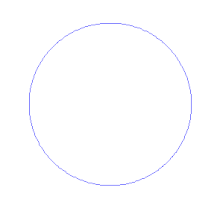User:Denevedr/sandbox
In quantum mechanics, the case of a particle in a one-dimensional ring is similar to the particle in a box. The system is composed of a single particle that has zero potential energy while on a circular ring, and infinite potential energy at all other points in space. This causes the particle to be bound to the ring, which leads to quantized energy levels. This model is one of the few quantum models which can be solved exactly. It is also a useful learning tool in demonstrating the concept of quantum angular momentum. The Schrödinger equation for a free particle which is restricted to a ring (whose configuration space is the circle ) is
- [1]
- In which psi represents the wave function of the particle, and the operator on the left side of the equation represents the Hamiltonian for the system. As the potential energy is zero on the ring, the Hamiltonian is entirely comprised by a kinetic energy component.
- The Schrödinger equation can also be represented in polar coordinates. Using this system (as opposed to a Cartesian coordinate system) will simplify further calculations.[2]

Two solutions to the Schrodinger Equation for a particle on a ring.
Wave function
[edit]Using polar coordinates on the 1-dimensional ring of radius R, the wave function depends only on the angular coordinate, and so

Any solution subject to boundary conditions will have quantization of angular momentum. For spherical models, the discrete nature in the allowed directions of the angular momentum vector can be visualized in the picture above. This is referred to as the quantization of space. This effect ultimately determines the shape and probability distribution of molecular orbitals in lower and higher energy levels.
Requiring that the wave function be periodic in with a period (from the demand that the wave functions be single-valued functions on the circle), and that they be normalized leads to the conditions
- ,
and
Under these conditions, the solution to the Schrödinger equation is given by
Energy eigenvalues
[edit]The energy eigenvalues are quantized because of the periodic boundary conditions, and they are required to satisfy
- , or
- [1]
The eigenfunctions and energy eigenvalues are
- where
Therefore, there are two degenerate quantum states for every value of (corresponding to ). Therefore, there are 2n+1 states with energies up to an energy indexed by the number n.
The case of a particle in a one-dimensional ring is an instructive example when studying the quantization of angular momentum for an electron orbiting the nucleus. The azimuthal wave functions in that case are identical to the energy eigenfunctions of the particle on a ring.
The statement that any wavefunction for the particle on a ring can be written as a superposition of energy eigenfunctions is identical to the Fourier theorem about the development of any periodic function in a Fourier series.

Angular Momentum of a Particle in a Ring
[edit]By constraining the motion of the particle to the x, y-plane, the angular momentum vector will be in the z direction. However, according to quantum mechanics, it is not possible to know the direction of the angular momentum vector. Our knowledge of the angular momentum does allow for the determination of the length of the angular momentum vector and any one component. If the vector is found in the z-axis, then the x and y components are zero and all three components are known[4].
Application
[edit]
In organic chemistry, aromatic compounds contain ring structures, such as benzene, consisting of five or six, usually carbon, atoms. So does the surface of "buckyballs" (buckminsterfullerene). This ring behaves like a circular waveguide, with the valence electrons orbiting in both directions. To fill all energy levels up to n requires electrons, as electrons have additionally two possible orientations of their spins. This is known as Hückel's rule. Continuous overlap of unhybridized p-orbitals around the ring gives exceptional stability (aromaticity). Because of this stability, the electrons of the pi system are bound to the ring structure; as such, the energies of the pi electrons can be well approximated by the particle on a ring system.
See also
[edit]References
[edit]- Angular Momentum, Chapter 6, Particle in a ring., pp 1.
- Mathematics for Chemists, slide 46, National Sun Yat Sen University[5]
- Particle in a ring, Rigid Rotor Approximation. MIT Open Courseware, Physical Chemistry, Lecture 16, pp 4-7
- Quantum Mechanics, Motion in a ring. Oregon State University, Lecture 3, pp 3-6
- Rigid Rotor Approximation for Quantum Mechanics, 7.5,3,A. Rigid Rotor
Bibliography
[edit]Levine, I. N. (2000). Quantum mechanics (5th ed.). Saddle River, N.J.: Pearson Education. ISBN 0136855121.
Bransden, B. H.; Joachain, C. J. (2000). Quantum mechanics (2nd ed.). Essex: Pearson Education. ISBN 0-582-35691-1.
Davies, John H. (2006). The Physics of Low-Dimensional Semiconductors: An Introduction (6th reprint ed.). Cambridge University Press. ISBN 0-521-48491-X.
Griffiths, David J. (2004). Introduction to Quantum Mechanics (2nd ed.). Prentice Hall. ISBN 0-13-111892-7.
External links
[edit]Mathematica Demonstration (Rigid Rotor)
Particle in a ring simulation video
- ^ a b "Physical Chemistry Lecture Notes, MIT Open Courseware" (PDF). Massachusetts Institute of Technology. Retrieved March 10, 2018.
- ^ Blinder, S.M. (January 2002). "Angular Momentum" (PDF). University of Michigan. Retrieved March, 10, 2018.
{{cite web}}: Check date values in:|access-date=(help) - ^ Manogue, Corrine. "Quantum Mechanics" (PDF). University of Oregon. Retrieved March 10, 2018.
- ^ "Quantum Mechanics, Angular Momentum". Chemistry Libre-texts. March 10, 2018. Retrieved March 10, 2018.
- ^ "Mathematics for Chemists". Department of Chemistry, Sun Yat Sen University. Retrieved March, 10, 2018.
{{cite web}}: Check date values in:|access-date=(help)




















